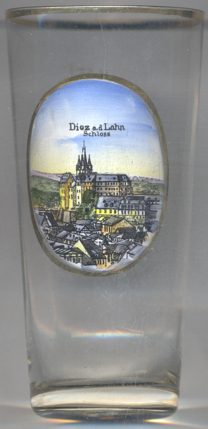

|
| DEUTSCHLAND | GERMANY |
| Bundesland: Rheinland-Pfalz | Rhineland-Palatinate |
| Landkreis: Rhein-Lahn-Kreis |
 Diez is situated at an elevation of 110 m at the confluence of the rivers Aar and Lahn in northeastern
Rhineland-Palatinate, about 4 km southwest of Limburg an der Lahn and about 31 km
east of Koblenz. The municipality has a population of about 11,000 (2016). It is also the
seat of the unified municipality (Verbandsgemeinde) Diez which also includes 22 other, independent communes.
Diez is situated at an elevation of 110 m at the confluence of the rivers Aar and Lahn in northeastern
Rhineland-Palatinate, about 4 km southwest of Limburg an der Lahn and about 31 km
east of Koblenz. The municipality has a population of about 11,000 (2016). It is also the
seat of the unified municipality (Verbandsgemeinde) Diez which also includes 22 other, independent communes.
The settlement was first mentioned as Theodissa in a charter of 790 AD where it is listed as property of the Abbey of Prüm. In 1329 Diez obtained the privileges of a town. The dynasty of the Counts of Diez ended in 1386 wit the death of the last male heir. The domains thereafter were inherited by the counts of Nassau and later Nassau-Dillenburg. The town later became the residence of the counts of Nassau-Diez, who in the 17th and 18th centuries became hereditary governors of the Spanish Netherlands and who became the founders of today's Dutch royal family. In 1806 the county of Nassau-Diez was incorporated into the duchy of Nassau (residence in Weilburg and from 1814 in Wiesbaden). In 1866 Nassau was incoporated into the kingdom of Prussia and in the following year Diez became the administrative seat of the district Unterlahnkreis (Lower Lahn district). In 1969 the districts Unterlahnkreis and Loreleykreis (Sankt Goarshausen) were merged into the new Rhein-Lahn district and the administrative seat was moved to Bad Ems.
 Diez castle [center] above the town goes back to a construction of the
11th century. In the following centuries, the castle was repeatedly enlarged. In the 15th century the castle was
transformed into a residence castle in early Renaissance style. From 1606 it was the residence of the counts of
Nassau-Diez (Orange-Nassau). Since the main residence of the counts was in the Netherlands, castle Diez was mainly
used as a dowager seat and later only as an administrative seat. In 1778/79 the castle was transformed into a gaol
and as such it was used until 1928. The city of Diez and Prussia wanted to donate the castle to the Dutch royal family
which, however, declined. Since 1953 the castle is home to a youth hostel, since the 1960s also a museum of Nassau
history.
Diez castle [center] above the town goes back to a construction of the
11th century. In the following centuries, the castle was repeatedly enlarged. In the 15th century the castle was
transformed into a residence castle in early Renaissance style. From 1606 it was the residence of the counts of
Nassau-Diez (Orange-Nassau). Since the main residence of the counts was in the Netherlands, castle Diez was mainly
used as a dowager seat and later only as an administrative seat. In 1778/79 the castle was transformed into a gaol
and as such it was used until 1928. The city of Diez and Prussia wanted to donate the castle to the Dutch royal family
which, however, declined. Since 1953 the castle is home to a youth hostel, since the 1960s also a museum of Nassau
history.
[https://de.wikipedia.org/wiki/Diez, https://en.wikipedia.org/wiki/Diez,_Germany,
https://de.wikipedia.org/wiki/Herzogtum_Nassau, https://de.wikipedia.org/wiki/Grafenschloss_Diez]
![[scale]](lineal.jpg)